Os shields TFT são ecrãs de LCD táteis para a exibição de imagens e a criação de interfaces de usuário, com grafismos mais ou menos complexos, para operar microcontroladores Arduino. Neste tutorial, usamos o shield Kuman TFT 3.5″ (muito próximo do shield 2.8″), mas ele pode ser aplicado para outros shields ou módulos LCD. Basta verificar os pinos utilizados e a compatibilidade da biblioteca.
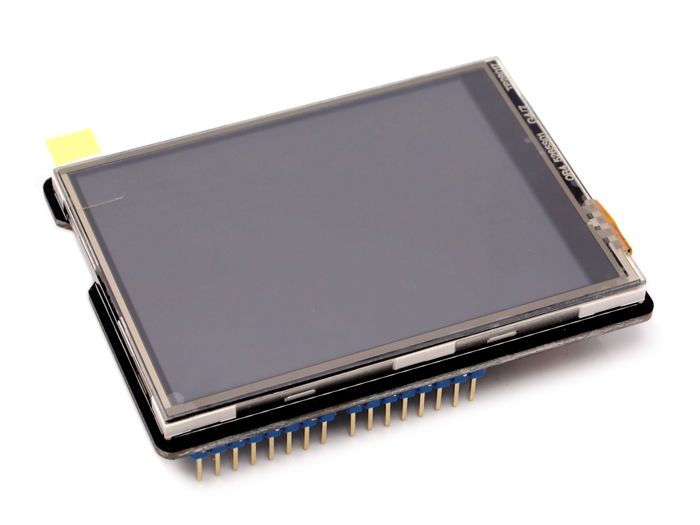
Material
- Computador
- Arduino UNO ou Mega
- Cabo USB A Macho/B Macho
- Shield LCD TFT
- Cartão SD (opcional)
Princípio de funcionamento
O shield TFT éequipado com um ecrã LCD sensível ao toque que permite exibir imagens a cores e criar interfaces com curvas e botões para interagir e visualizar dados do Arduino. Ele também é equipado com um leitor de cartões micro SD, que pode servir para guardar imagens ou outros dados.
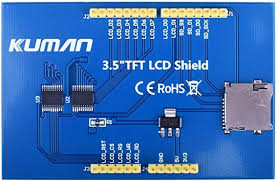
Esquema
O shield TFT é colocado diretamente sobre uma placa Arduino UNO ou Mega. O shield utiliza quase todos os pinos do Arduino UNO. Certifique-se de não usar os mesmos pinos para outros módulos,
Para informação, os pinos disponíveis são:
- pino analógico A5
- pino digital 0
- pino digital 1
Se a funcionalidade tátil do ecrã não for ser utilizada, também é possível usar os pinos A1, A2, 6 e 7.
Se estiver usando um módulo shield ou LCD diferente, verifique bem os pinos a serem utilizados (pinagem).
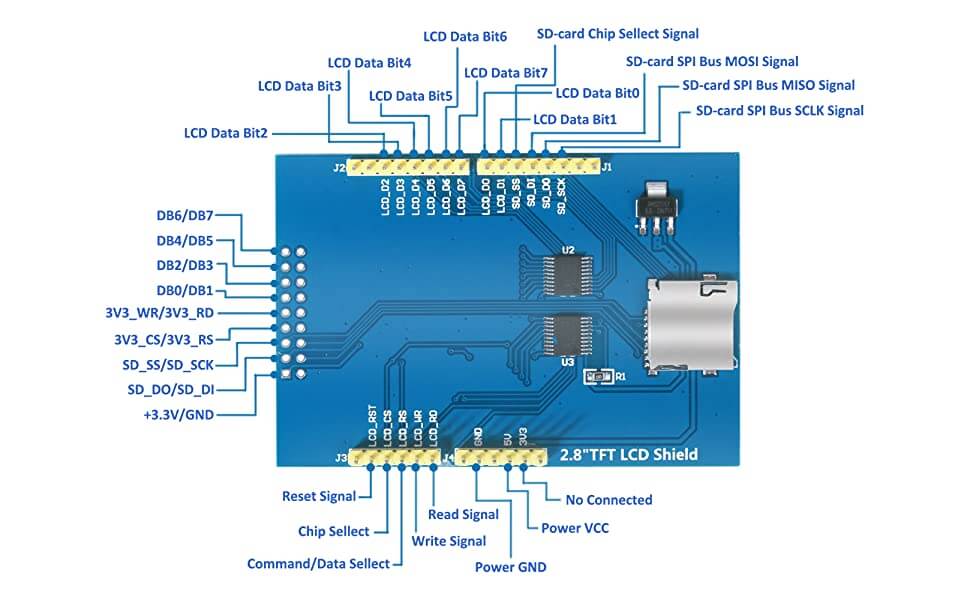
Calibrar o TouchScreen
Nenhum ecrâ é igual a outro, e para poder utilizá-los corretamente, é preciso obter os valores corretos das dimensões para adaptar a exibição e a detecção da pressão. Para isso, carregamos o código TouchScreen_Calibr_native.ino, presente nos exemplos da biblioteca MCUFRIEND_kbv.h.
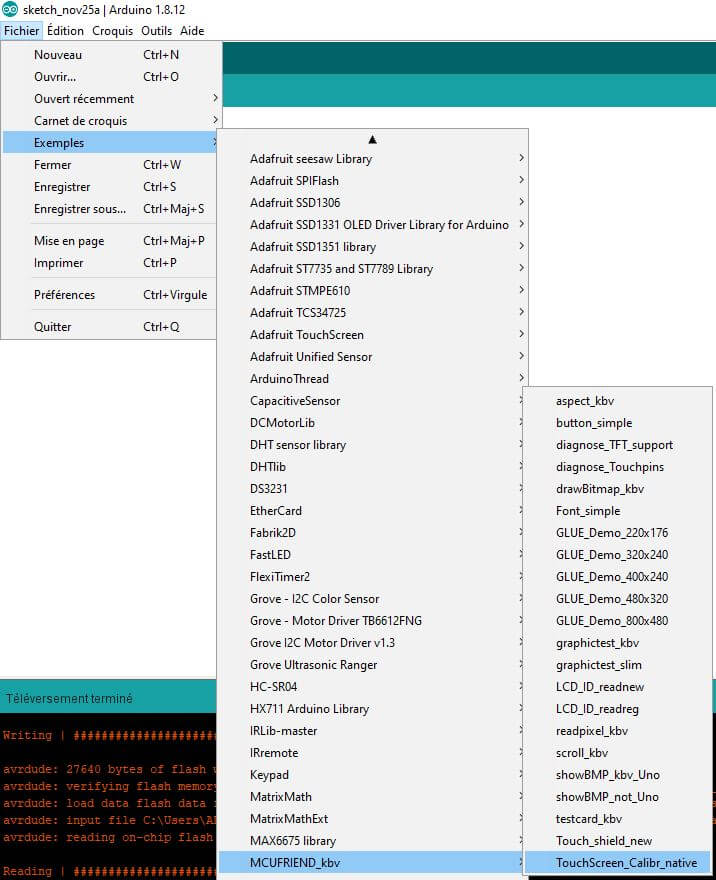
Uma vez carregado o código, usamos uma caneta para pressionar, segurar e soltar em vários pontos do ecrã e assim calibrá-lo. Depois disso, as configurações serão exibidas no monitor serial e no ecrã.
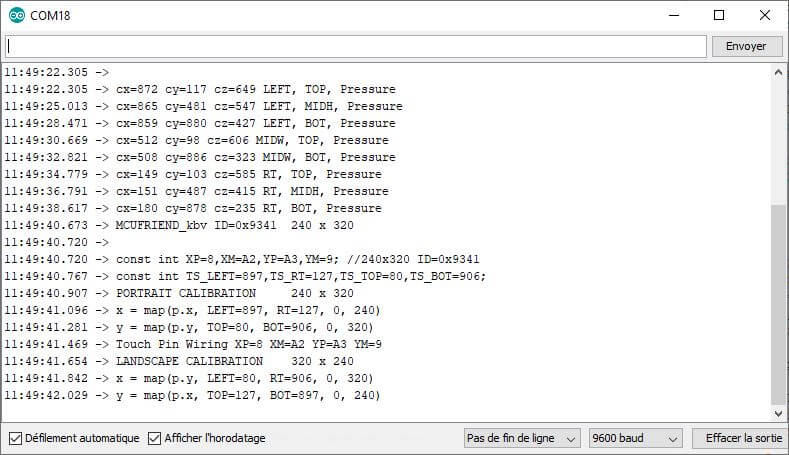
Aqui estão os resultados para o Shiel LCD TFT 3.5″
//3.5 Calibration
const int XP = 8, XM = A2, YP = A3, YM = 9; //320x480 ID=0x9486
const int TS_LEFT = 144, TS_RT = 887, TS_TOP = 936, TS_BOT = 87;E para o Shield LCD TFT 2.8″
//2.8 Calibration
const int XP=8,XM=A2,YP=A3,YM=9; //240x320 ID=0x9341
const int TS_LEFT=907,TS_RT=120,TS_TOP=74,TS_BOT=913;Código
Para utilizar o objeto TftScreen, usamos as bibliotecas SD.h, Adafruit_GFX.h, MCUFRIEND_kbv.h, e TouchScreen.h, que permitem gerir a comunicação com o cartão SD, a criação de grafismos, o controle do ecrã e o toque. Este exemplo mostra como é fácil utilizar o ecrã (lembre-se de adaptá-lo ao seu equipamento).
//Libraries
#include <SD.h>//https://www.arduino.cc/en/reference/SD
#include <Adafruit_GFX.h>//https://github.com/adafruit/Adafruit-GFX-Library
#include <MCUFRIEND_kbv.h>//https://github.com/prenticedavid/MCUFRIEND_kbv
#include <TouchScreen.h> //https://github.com/adafruit/Adafruit_TouchScreen
//Constants
#define SD_CS 10
#define BLACK 0
#define GREY 21845
#define BLUE 31
#define RED 63488
#define GREEN 2016
#define DARKGREEN 1472
#define CYAN 2047
#define MAGENTA 63519
#define YELLOW 65504
#define GOLD 56768
#define WHITE 65535
//Touch screen configuration
#define MINPRESSURE 200
#define MAXPRESSURE 1000
// ALL Touch panels and wiring is DIFFERENT
// copy-paste results from TouchScreen_Calibr_native.ino
//3.5 Parameters
const int XP = 8, XM = A2, YP = A3, YM = 9; //320x480 ID=0x9486
const int TS_LEFT = 144, TS_RT = 887, TS_TOP = 936, TS_BOT = 87;
//2.8 Parameters
//const int XP = 8, XM = A2, YP = A3, YM = 9; //240x320 ID=0x9341
//const int TS_LEFT = 907, TS_RT = 120, TS_TOP = 74, TS_BOT = 913;
TouchScreen ts = TouchScreen(XP, YP, XM, YM, 300);
TSPoint p;
bool down;
int pixel_x, pixel_y; //Touch_getXY() updates global vars
//Variables
int currentPage = 0, oldPage = -1;
//Objects
MCUFRIEND_kbv tft;
// Button calibration
Adafruit_GFX_Button page1_btn, page2_btn;
int margin = 5;
int btnWidth = 100;
int btnHeight = 40;
int btnY = 200;
void setup() {
//Init Serial USB
Serial.begin(9600);
Serial.println(F("Initialize System"));
//Init tft screen
uint16_t ID = tft.readID();
if (ID == 0xD3D3) ID = 0x9486; //for 3.5" TFT LCD Shield , 0x9341 for 2.8" TFT LCD Shield
tft.begin(ID);
tft.setRotation(1);//0-PORTRAIT 1-PAYSAGE 2-REVERSE PORTRAIT 3-REVERSE PAYSAGE
//Uncomment if you are using SD
/*if (!SD.begin(SD_CS)) {
Serial.println(F("initialization failed!"));
return;
}*/
currentPage = 0; // Indicates that we are at Home Screen
}
void loop() {
down = Touch_getXY();
switch (currentPage) {
case 0:
if (currentPage != oldPage) {
Serial.println(F("Page 1"));
drawPage1();
}
page2_btn.press(down && page2_btn.contains(pixel_x, pixel_y));
//if (page2_btn.justReleased()) page2_btn.drawButton();
if (page2_btn.justPressed()) {
currentPage = 1;
}
break;
case 1:
if (currentPage != oldPage) {
Serial.println(F("Page 2"));
drawPage2();
}
page1_btn.press(down && page1_btn.contains(pixel_x, pixel_y));
//if (page1_btn.justReleased()) page1_btn.drawButton();
if (page1_btn.justPressed()) {
currentPage = 0;
}
break;
}
}
void drawPage1() { /* function drawHomePage */
tft.setRotation(1);
tft.fillScreen(BLACK);
//Title
tft.setCursor(0, 10);
tft.setTextSize(3);
tft.setTextColor(WHITE, BLACK);
tft.print("This is page 1"); // Prints the string on the screen
tft.drawLine(0, 32, 319, 32, DARKGREEN); // Draws the red line
//text
tft.setTextSize(3);
tft.setTextColor(RED, BLACK);
tft.setCursor(tft.width() / 2. - 14 * 3 * 3, 80);
tft.print(" Go to page 2 ");
//Button
page2_btn.initButton(&tft, tft.width() / 2., 200, 2 * btnWidth, btnHeight, WHITE, GREEN, BLACK, "Page 2", 2);
page2_btn.drawButton(false);
oldPage = currentPage;
}
void drawPage2() { /* function drawHomePage */
tft.setRotation(1);
tft.fillScreen(GREY);
//Title
tft.setCursor(0, 10);
tft.setTextSize(3);
tft.setTextColor(WHITE, GREY);
tft.print("This is page 2"); // Prints the string on the screen
tft.drawLine(0, 32, 319, 32, DARKGREEN); // Draws the red line
//text
tft.setTextSize(3);
tft.setTextColor(GREEN, BLACK);
tft.setCursor(tft.width() / 2. - 14 * 3 * 3, 80);
tft.print(" Go to page 1 ");
//Button
page1_btn.initButton(&tft, tft.width() / 2., 200, 2 * btnWidth, btnHeight, WHITE, RED, BLACK, "Page 1", 2);
page1_btn.drawButton(false);
oldPage = currentPage;
}
/************************************************************************************
UTILITY FUNCTION
*************************************************************************************/
bool Touch_getXY(void)
{
p = ts.getPoint();
pinMode(YP, OUTPUT); //restore shared pins
pinMode(XM, OUTPUT);
digitalWrite(YP, HIGH);
digitalWrite(XM, HIGH);
bool pressed = (p.z > MINPRESSURE && p.z < MAXPRESSURE);
if (pressed) {
if (tft.width() <= tft.height()) { //Portrait
pixel_x = map(p.x, TS_LEFT, TS_RT, 0, tft.width()); //.kbv makes sense to me
pixel_y = map(p.y, TS_TOP, TS_BOT, 0, tft.height());
} else {
pixel_x = map(p.y, TS_TOP, TS_BOT, 0, tft.width());
pixel_y = map(p.x, TS_RT, TS_LEFT, 0, tft.height());
}
}
return pressed;
}
Bônus: Exemplo de interface gráfica
Neste exemplo, vamos criar uma interface gráfica para mostrar diferentes funcionalidades que podem ser desenvolvidas com o shield TFT.
Lembre-se de adaptá-lo conforme as configurações do seu ecrã.
#include <Adafruit_GFX.h>
#include <MCUFRIEND_kbv.h>
MCUFRIEND_kbv tft;
#include <TouchScreen.h>
#include <Fonts/FreeSans9pt7b.h>
#include <Fonts/FreeSans12pt7b.h>
#include <Fonts/FreeSerif12pt7b.h>
#include <FreeDefaultFonts.h>
#define MINPRESSURE 200
#define MAXPRESSURE 1000
// ALL Touch panels and wiring is DIFFERENT
// copy-paste results from TouchScreen_Calibr_native.ino
//3.5 Calibration
const int XP = 8, XM = A2, YP = A3, YM = 9; //320x480 ID=0x9486
const int TS_LEFT = 144, TS_RT = 887, TS_TOP = 936, TS_BOT = 87;
/*PORTRAIT CALIBRATION 320 x 480
x = map(p.x, LEFT=144, RT=887, 0, 320)
y = map(p.y, TOP=936, BOT=87, 0, 480)
Touch Pin Wiring XP=8 XM=A2 YP=A3 YM=9
LANDSCAPE CALIBRATION 480 x 320
x = map(p.y, LEFT=936, RT=87, 0, 480)
y = map(p.x, TOP=887, BOT=144, 0, 320)*/
//2.8 Calbiration
//const int XP=8,XM=A2,YP=A3,YM=9; //240x320 ID=0x9341
//const int TS_LEFT=907,TS_RT=120,TS_TOP=74,TS_BOT=913;
/*PORTRAIT CALIBRATION 240 x 320
x = map(p.x, LEFT=907, RT=120, 0, 240)
y = map(p.y, TOP=74, BOT=913, 0, 320)
Touch Pin Wiring XP=8 XM=A2 YP=A3 YM=9
LANDSCAPE CALIBRATION 320 x 240
x = map(p.y, LEFT=74, RT=913, 0, 320)
y = map(p.x, TOP=120, BOT=907, 0, 240)*/
TouchScreen ts = TouchScreen(XP, YP, XM, YM, 300);
TSPoint p;
Adafruit_GFX_Button on_btn, off_btn, page1_btn, page2_btn, page3_btn;
Adafruit_GFX_Button ok_btn, cncl_btn, plus_btn, minus_btn;
Adafruit_GFX_Button menu_btn, info_btn, back_btn;
int pixel_x, pixel_y; //Touch_getXY() updates global vars
// Button calibration
int margin = 5;
int btnWidth = 100;
int btnHeight = 40;
int btnY = 200;
// Software variable
bool enable_nuit = false;
int parameter = 50, old_parameter = 50;
long temp0 = 60;
long temp1 = 25.5;
long temp2 = 40;
long temp3 = 35.6;
#define BLACK 0x0000
#define GREY 0x5555
#define BLUE 0x001F
#define RED 0xF800
#define GREEN 0x07E0
#define DARKGREEN 0x05C0
#define CYAN 0x07FF
#define MAGENTA 0xF81F
#define YELLOW 0xFFE0
#define GOLD 0xDDC0
#define WHITE 0xFFFF
enum pageId {
MENU,
SENSOR,
CMD,
PARAM,
INFO
};
unsigned int currentPage = MENU, oldPage = -1;
void setup(void)
{
Serial.begin(9600);
//init TFTTouch
uint16_t ID = tft.readID();
Serial.print("TFT ID = 0x");
Serial.println(ID, HEX);
Serial.println(F("Calibrate for your Touch Panel"));
if (ID == 0xD3D3) ID = 0x9486; //for 3.5" TFT LCD Shield , 0x9341 for 2.8" TFT LCD Shield
tft.begin(ID);
tft.setRotation(1); //0-PORTRAIT 1-PAYSAGE 2-REVERSE PORTRAIT 3-REVERSE PAYSAGE
//tft.setFont(&FreeSmallFont);
/*if (!SD.begin(SD_CS)) {
Serial.println(F("initialization failed!"));
return;
}*/
currentPage = MENU; // Indicates that we are at Home Screen
Serial.println("Home Page");
}
bool down ;
void loop(void) {
switch (currentPage) {
case MENU: //Menu page
if (currentPage != oldPage) drawMenuScreen();
page1_btn.press(down && page1_btn.contains(pixel_x, pixel_y));
page2_btn.press(down && page2_btn.contains(pixel_x, pixel_y));
page3_btn.press(down && page3_btn.contains(pixel_x, pixel_y));
if (page1_btn.justReleased())
page1_btn.drawButton();
if (page2_btn.justReleased())
page2_btn.drawButton();
if (page3_btn.justReleased())
page3_btn.drawButton();
if (page1_btn.justPressed()) {
page1_btn.drawButton(true);
currentPage = SENSOR;
}
if (page2_btn.justPressed()) {
page2_btn.drawButton(true);
currentPage = CMD;
}
if (page3_btn.justPressed()) {
page3_btn.drawButton(true);
currentPage = PARAM;
}
break;
case SENSOR:
if (currentPage != oldPage) drawSensorScreen();
readSensor();
updateTemp();
menu_btn.press(down && menu_btn.contains(pixel_x, pixel_y));
info_btn.press(down && info_btn.contains(pixel_x, pixel_y));
if (menu_btn.justReleased())
menu_btn.drawButton();
if (info_btn.justReleased())
info_btn.drawButton();
if (menu_btn.justPressed()) {
menu_btn.drawButton(true);
currentPage = MENU;
}
if (info_btn.justPressed()) {
info_btn.drawButton(true);
currentPage = INFO;
}
break;
case CMD:
if (currentPage != oldPage) drawCmdScreen();
on_btn.press(down && on_btn.contains(pixel_x, pixel_y));
off_btn.press(down && off_btn.contains(pixel_x, pixel_y));
back_btn.press(down && back_btn.contains(pixel_x, pixel_y));
if (back_btn.justReleased())
back_btn.drawButton();
if (on_btn.justReleased())
on_btn.drawButton();
if (off_btn.justReleased())
off_btn.drawButton();
if (back_btn.justPressed()) {
back_btn.drawButton(true);
currentPage = MENU;
}
if (on_btn.justPressed()) {
on_btn.drawButton(true);
tft.fillRect(tft.width() / 2. - (btnWidth + 40) / 2, btnY - 4 * margin - (btnHeight) / 2 - (btnHeight + 40), btnWidth + 40, btnHeight + 40, GREEN);
Serial.println(F("Set ON"));
}
if (off_btn.justPressed()) {
off_btn.drawButton(true);
tft.fillRect(tft.width() / 2. - (btnWidth + 40) / 2, btnY - 4 * margin - (btnHeight) / 2 - (btnHeight + 40), btnWidth + 40, btnHeight + 40, RED);
Serial.println(F("Set OFF"));
}
break;
case PARAM: //consigne
if (currentPage != oldPage) drawParamScreen();
plus_btn.press(down && plus_btn.contains(pixel_x, pixel_y));
minus_btn.press(down && minus_btn.contains(pixel_x, pixel_y));
ok_btn.press(down && ok_btn.contains(pixel_x, pixel_y));
cncl_btn.press(down && cncl_btn.contains(pixel_x, pixel_y));
if (plus_btn.justReleased())
plus_btn.drawButton();
if (minus_btn.justReleased())
minus_btn.drawButton();
if (ok_btn.justReleased())
ok_btn.drawButton();
if (cncl_btn.justReleased())
cncl_btn.drawButton();
if (plus_btn.justPressed()) {
plus_btn.drawButton(true);
parameter += 1;
Serial.print(F("Consigne : "));
Serial.println(parameter);
drawTextInRect(tft.width() / 2., 60 + 3 * 4 + 6 * 8, parameter, 4, RED, BLACK);
}
if (minus_btn.justPressed()) {
minus_btn.drawButton(true);
parameter -= 1;
Serial.print(F("Consigne : "));
Serial.println(parameter);
drawTextInRect(tft.width() / 2., 60 + 3 * 4 + 6 * 8, parameter, 4, RED, BLACK);
}
if (ok_btn.justPressed()) {
ok_btn.drawButton(true);
Serial.println(F("Valider"));
validateScreen();
delay(1000);
currentPage = MENU;
}
if (cncl_btn.justPressed()) {
cncl_btn.drawButton(true);
parameter = old_parameter;
Serial.println(F("Annule "));
cancelScreen();
delay(1000);
currentPage = MENU;
}
break;
case INFO:
if (currentPage != oldPage) drawInfoScreen();
if (Touch_getXY()) {
currentPage = MENU;
}
break;
}
if (oldPage == currentPage){
down = Touch_getXY();
}else{
down=false;
}
}
/************************************************************************************
SCREENS DEFINTION
************************************************************************************/
void drawMenuScreen() {
tft.fillScreen(BLACK);
tft.setTextSize(2);
// Title
tft.setTextColor(WHITE, BLACK);
tft.setCursor(0, 10);
tft.print("Exemple de menu"); // Prints the string on the screen
tft.drawLine(0, 32, tft.width() * 0.6, 32, DARKGREEN); // Draws the red line
tft.setTextColor(WHITE, BLACK);//((255, 255, 255), (0,0,0));
tft.setCursor(0, 80);
tft.setTextColor(GREEN, BLACK);//((255, 255, 255), (0,0,0));
// Button
page1_btn.initButton(&tft, tft.width() / 2. , tft.height() / 2. - (1.*btnHeight + margin), 2 * btnWidth, btnHeight, WHITE, GREEN, BLACK, "SENSOR", 2);
page2_btn.initButton(&tft, tft.width() / 2., tft.height() / 2., 2 * btnWidth, btnHeight, WHITE, GREEN, BLACK, "COMMAND", 2);
page3_btn.initButton(&tft, tft.width() / 2., tft.height() / 2. + (1.*btnHeight + margin), 2 * btnWidth, btnHeight, WHITE, GREEN, BLACK, "PARAMETER", 2);
page1_btn.drawButton(false);
page2_btn.drawButton(false);
page3_btn.drawButton(false);
//Button frame
tft.drawRoundRect(tft.width() / 2. - 1.5 * btnWidth, tft.height() / 2. - (1.5 * btnHeight + 2 * margin), 2 * btnWidth + btnWidth, 3 * btnHeight + 4 * margin, 10, GREEN);
oldPage = currentPage;
}
void readSensor() {
temp0 = temp0 + random(-25, 25) / 10;
temp1 = temp1 + random(-25, 25) / 10;
temp2 = temp2 + random(-25, 25) / 10;
temp3 = temp3 + random(-25, 25) / 10;
}
void drawSensorScreen() {
tft.fillScreen(BLACK);
tft.drawLine(tft.width() / 2., 0, tft.width() / 2., tft.height(), WHITE);
tft.drawLine(0, tft.height() / 2., tft.width(), tft.height() / 2., WHITE);
updateTemp();
tft.setTextSize(1);
// bouton centré X,Y
menu_btn.initButton(&tft, tft.width() / 2. - btnWidth - margin , tft.height() - btnHeight / 2., btnWidth, btnHeight, WHITE, GREY, BLACK, "MENU", 2);
info_btn.initButton(&tft, tft.width() / 2. + btnWidth + margin, tft.height() - btnHeight / 2., btnWidth, btnHeight, WHITE, GREY, BLACK, "INFO", 2);
menu_btn.drawButton(false);
info_btn.drawButton(false);
oldPage = currentPage;
}
void updateTemp() {
//temp1
if (parameter < temp0) { //(abs(parameter-temp0)<1){
drawTextInRect(tft.width() / 4., tft.height() / 4., temp0, 5, GREEN, 255);
} else {
drawTextInRect(tft.width() / 4., tft.height() / 4., temp0, 5, RED, 255);
}
drawTextInRect(3 * tft.width() / 4., tft.height() / 4., temp1, 5, RED, 255);
drawTextInRect(tft.width() / 4., 3 * tft.height() / 4., temp2, 5, RED, 255);
drawTextInRect(3 * tft.width() / 4., 3 * tft.height() / 4., temp3, 5, RED, 255);
}
void drawCmdScreen() {
tft.setRotation(1); //PORTRAIT
tft.setTextSize(1);
tft.fillScreen(BLACK);
back_btn.initButton(&tft, 60 , 20, btnWidth, btnHeight, BLACK, BLACK, WHITE, "<- Back", 2);
// bouton centré X,Y
on_btn.initButton(&tft, tft.width() / 2. - btnWidth / 2. , btnY, btnWidth, btnHeight, WHITE, GREEN, BLACK, "ON", 2);
off_btn.initButton(&tft, tft.width() / 2. + btnWidth / 2. + margin, btnY, btnWidth, btnHeight, WHITE, RED, BLACK, "OFF", 2);
back_btn.drawButton(false);
on_btn.drawButton(false);
off_btn.drawButton(false);
tft.fillRect(tft.width() / 2. - (btnWidth + 40) / 2, btnY - 4 * margin - (btnHeight) / 2 - (btnHeight + 40), btnWidth + 40, btnHeight + 40, RED);
oldPage = currentPage;
}
void validateScreen() {
tft.setRotation(1);
tft.fillScreen(BLACK);
tft.setTextSize(5);
tft.setTextColor(BLACK, GREEN);
tft.setCursor(tft.width() / 2. - 6 * 6 * 4, tft.height() / 2. - 1 * 6);
tft.print(" VALIDE ");
}
void cancelScreen() {
tft.setRotation(1);
tft.fillScreen(BLACK);
tft.setTextSize(5);
tft.setTextColor(BLACK, RED);
tft.setCursor(tft.width() / 2. - 6 * 6 * 4, tft.height() / 2. - 1 * 6);
tft.print(" ANNULE ");
}
void drawParamScreen() {
tft.setRotation(1);
tft.fillScreen(BLACK);
//Title
tft.setTextSize(3);
tft.setTextColor(WHITE, BLACK);
tft.setCursor(tft.width() / 2. - 9 * 3 * 3, 50);
tft.print("Parameter");
ok_btn.initButton(&tft, 2 + btnWidth / 2., btnHeight / 2. + margin, btnWidth, btnHeight, WHITE, DARKGREEN, BLACK, "Valider", 2);
cncl_btn.initButton(&tft, tft.width() - btnWidth / 2 - 2, btnHeight / 2. + margin, btnWidth, btnHeight, WHITE, RED, BLACK, "Annuler", 2);
ok_btn.drawButton(false);
cncl_btn.drawButton(false);
drawTextInRect(tft.width() / 2., 60 + 3 * 4 + 6 * 8, parameter, 4, RED, BLACK);
plus_btn.initButton(&tft, tft.width() / 2. - btnWidth / 2. , 60 + 3 * 4 + 6 * 8 + (btnWidth - 30), btnWidth - 20, btnWidth - 30, WHITE, GREEN, BLACK, "+", 5);
minus_btn.initButton(&tft, tft.width() / 2. + btnWidth / 2. + margin, 60 + 3 * 4 + 6 * 8 + (btnWidth - 30), btnWidth - 20, btnWidth - 30, WHITE, GREEN, BLACK, "-", 5);
plus_btn.drawButton(false);
minus_btn.drawButton(false);
oldPage = currentPage;
}
void drawInfoScreen() {
tft.setRotation(1);
tft.fillScreen(BLACK);//(100, 155, 203)
tft.drawRoundRect(10, 50, tft.width() - 20, tft.height() - 60, 5, GREEN); //tft.fillRect (10, 10, 60, 36);
tft.setTextSize(2);
tft.setTextColor(WHITE, BLACK);
tft.setCursor(70, 18);
tft.print("Information sur l'exemple");
tft.setTextSize(2);
tft.setTextColor(WHITE, BLACK);
tft.setCursor(25, 80);
tft.print("En cas de probleme avec ce tutoriel,\n n'hesitez pas a nous contacter");
tft.setCursor(20, 245);
tft.print("www.aranacorp.com" );
oldPage = currentPage;
}
/************************************************************************************
UTILITY FUNCTION
*************************************************************************************/
void drawTextInRect(int x, int y, long temp, int tsize, unsigned int fColor, unsigned int bColor) {
int marg = 10;
char buf[12];
int nbChar = strlen(itoa(temp, buf, 10)) + 2;
if (bColor != 255) tft.fillRect(x - nbChar * 3 * tsize - marg, y - nbChar * 1 * tsize - marg, nbChar * 6 * tsize + 2 * marg, nbChar * 2 * tsize + 2 * marg, bColor);
tft.setTextSize(tsize);
tft.setTextColor(fColor, BLACK);
//tft.setCursor(x-strlen(*text)*3*tsize+marg, y+rheight/2.+marg);
tft.setCursor(x - nbChar * 3 * tsize, y - nbChar * 1 * tsize);
tft.print(temp);
//while(*text) tft.print(*text++);
tft.write(0xF7);
tft.print("C");
}
bool Touch_getXY(void)
{
p = ts.getPoint();
pinMode(YP, OUTPUT); //restore shared pins
pinMode(XM, OUTPUT);
digitalWrite(YP, HIGH);
digitalWrite(XM, HIGH);
bool pressed = (p.z > MINPRESSURE && p.z < MAXPRESSURE);
if (pressed) {
if (tft.width() <= tft.height()) { //Portrait
pixel_x = map(p.x, TS_LEFT, TS_RT, 0, tft.width()); //.kbv makes sense to me
pixel_y = map(p.y, TS_TOP, TS_BOT, 0, tft.height());
} else {
pixel_x = map(p.y, TS_TOP, TS_BOT, 0, tft.width());
pixel_y = map(p.x, TS_RT, TS_LEFT, 0, tft.height());
}
}
return pressed;
}
Aplicações
- Criar uma interface gráfica para controlar o seu projeto Arduino
Fontes
- https://www.arduino.cc/en/reference/SD
- https://github.com/adafruit/Adafruit-GFX-Library
- https://github.com/prenticedavid/MCUFRIEND_kbv
Retrouvez nos tutoriels et d’autres exemples dans notre générateur automatique de code
La Programmerie